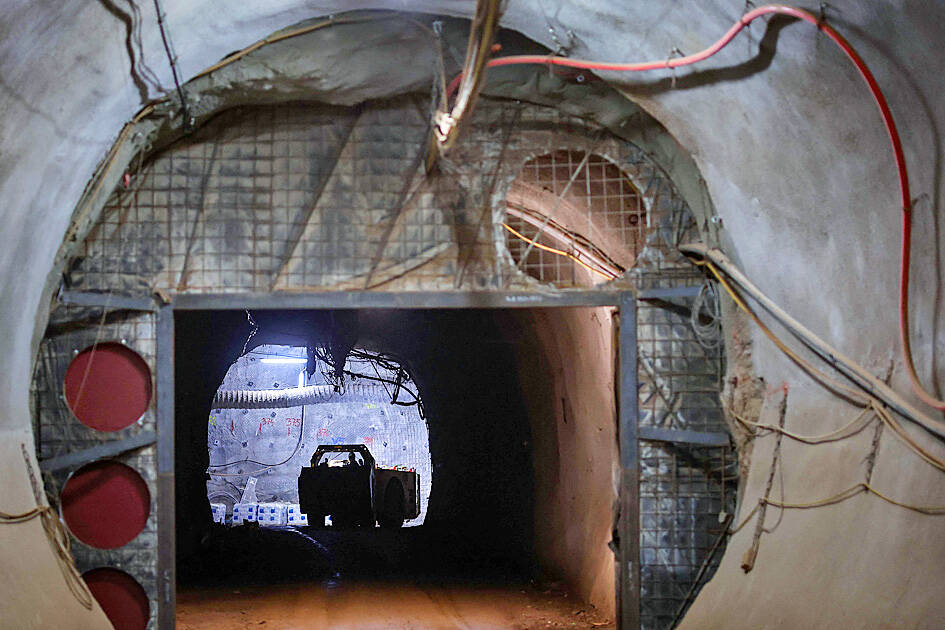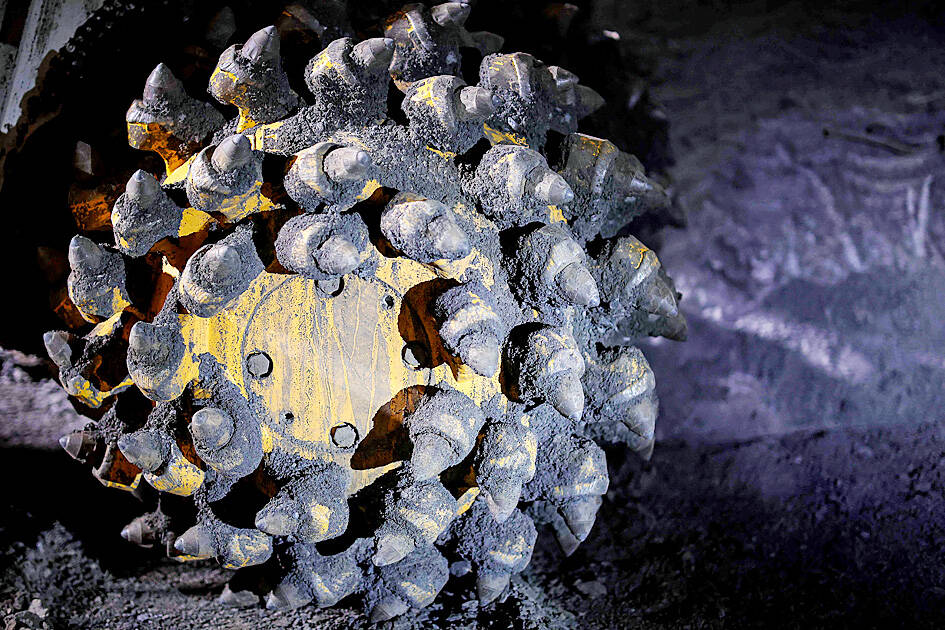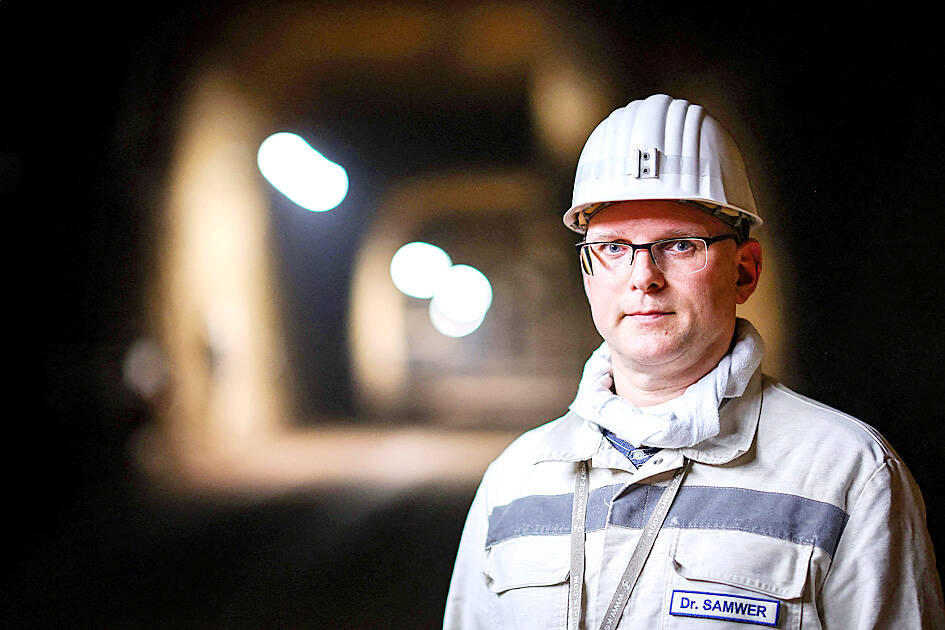An elevator rattles down about 1km below ground in five minutes to reach Germany’s nuclear necropolis, a future repository set to entomb much of its radioactive waste.
At the bottom, a jeep ride takes helmet-clad engineers and visitors through an underground tunnel complex into a cold, cavernous hall with concrete-lined walls that rise up about 15m.
Atomic waste is to be encased in concrete at the subterranean Konrad repository “to prevent the radioactive substances from being released into the air,” project manager Ben Samwer said.

Photo: AFP
“The safety levels we want to achieve require a high degree of care,” Samwer told reporters during a visit to the multibillion-dollar project deep below the western city of Salzgitter.
The former iron ore mine is to become the final resting place for waste from the atomic power plants that Europe’s top economy has shuttered over the past few years.
Protests raged for decades in Germany over where to put its nuclear waste, leaving the Konrad site as the only approved location so far.

Photo: AFP
Konrad is meant to start operating in the early 2030s with space for more than 300,000m3 of material with low and intermediate levels of contamination.
However, more than a year since Germany’s last reactor was taken off the grid, under a nuclear phase-out decided following Japan’s 2011 Fukushima Dai-ichi disaster, the political issue is far from buried.
Besides the technical challenge, developers have battled protests and legal resistance which saw activists, unions and local representatives lodge a new challenge last month.

Photo: AFP
Environmental group Nabu said that the Konrad project was a “relic” that “does not meet the requirements for safe storage” and needs to be abandoned.
Below ground, the engineers are pushing on, confident they can clear the technical and political hurdles.
Germany has a “problem” with the leftovers from nuclear power projects, construction manager Christian Gosberg told reporters. “We cannot leave it for decades or centuries above ground where it is now.”
However, building a storage facility has proved “significantly more complex” than he expected when he joined the project six years ago, Gosberg said.
The expansion of the old mine comes with “special challenges,” he said, adding that much of the machinery used to excavate the tunnels has to be taken apart and reassembled underground.
In some cases, every piece of rebar has to be placed by workers and “individually screwed together,” Gosberg said. “The whole process is extremely complicated and of course takes a lot of time.”
Building delays have pushed the opening back and driven up the cost to about 5.5 billion euros (US$5.9 billion).
Meanwhile, the search for more sites goes on — Germany will need to find another two underground locations to accommodate yet more nuclear waste. For highly radioactive material, the difficult search for a safe place might last another half a century, the German government has said.
Mass protests around other earmarked locations through the 1980s and 1990s led to the abandonment of other sites, including at the nearby Asse mine and a facility by the town of Gorleben.
For Germany’s anti-nuclear movement, the closure of the last atomic reactor was a “huge success,” said activist Ursula Schoenberger, for whom the campaign has lasted about 40 years.
“At the same time, the problem of nuclear waste is still there and we have to deal with it,” Schoenberger said.

Seven people sustained mostly minor injuries in an airplane fire in South Korea, authorities said yesterday, with local media suggesting the blaze might have been caused by a portable battery stored in the overhead bin. The Air Busan plane, an Airbus A321, was set to fly to Hong Kong from Gimhae International Airport in southeastern Busan, but caught fire in the rear section on Tuesday night, the South Korean Ministry of Land, Infrastructure and Transport said. A total of 169 passengers and seven flight attendants and staff were evacuated down inflatable slides, it said. Authorities initially reported three injuries, but revised the number

‘BALD-FACED LIE’: The woman is accused of administering non-prescribed drugs to the one-year-old and filmed the toddler’s distress to solicit donations online A social media influencer accused of filming the torture of her baby to gain money allegedly manufactured symptoms causing the toddler to have brain surgery, a magistrate has heard. The 34-year-old Queensland woman is charged with torturing an infant and posting videos of the little girl online to build a social media following and solicit donations. A decision on her bail application in a Brisbane court was yesterday postponed after the magistrate opted to take more time before making a decision in an effort “not to be overwhelmed” by the nature of allegations “so offensive to right-thinking people.” The Sunshine Coast woman —

A colossal explosion in the sky, unleashing energy hundreds of times greater than the Hiroshima bomb. A blinding flash nearly as bright as the sun. Shockwaves powerful enough to flatten everything for miles. It might sound apocalyptic, but a newly detected asteroid nearly the size of a football field now has a greater than 1 percent chance of colliding with Earth in about eight years. Such an impact has the potential for city-level devastation, depending on where it strikes. Scientists are not panicking yet, but they are watching closely. “At this point, it’s: ‘Let’s pay a lot of attention, let’s

BORDER SERVICES: With the US-funded International Rescue Committee telling clinics to shut by tomorrow, Burmese refugees face sudden discharge from Thai hospitals Healthcare centers serving tens of thousands of refugees on the Thai-Myanmar border have been ordered shut after US President Donald Trump froze most foreign aid last week, forcing Thai officials to transport the sickest patients to other facilities. The International Rescue Committee (IRC), which funds the clinics with US support, told the facilities to shut by tomorrow, a local official and two camp committee members said. The IRC did not respond to a request for comment. Trump last week paused development assistance from the US Agency for International Development for 90 days to assess compatibility with his “America First” policy. The freeze has thrown